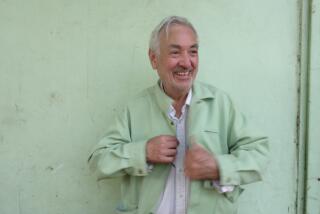The lord of all architects
RICHARD ROGERS, an Italian-born Englishman who wields political clout as a liberal member of Britain’s House of Lords and the unpaid chief of the London city government’s Architecture and Urbanism Unit, was named the winner Wednesday of the 2007 Pritzker Architecture Prize, the profession’s leading award.
Rogers’ signature buildings over the last 30 years include heralded temples to art (the Pompidou Center museum in Paris, co-designed with Renzo Piano), commerce (the Lloyd’s of London insurance tower), entertainment (the Millennium Dome in Greenwich, England) and transportation (a new terminal at the Madrid airport). The air terminal won Rogers, at age 73, the 2006 Stirling Prize for the best building by a British architect.
The Pompidou Center, disparaged by many critics when it opened in 1977, went on to be regarded as one of the most influential buildings of the late 20th century for its “inside-out” design, which placed mechanical viscera such as pipes and electrical conduits in full, brightly color-coded view. It touched off a trend toward architecturally distinctive “destination” buildings for arts and culture that has not slackened.
The $100,000 Pritzker prize has been awarded since 1979 by the Chicago-based Hyatt Foundation -- established by the Pritzker family, whose business is the Hyatt hotel chain -- and goes to a living architect for career achievement rather than for a specific building or series of buildings. Rogers is to receive his bronze medallion at a June 4 ceremony in London.
In a weekend telephone interview from his home in the British capital’s Chelsea section, Rogers said he had not grown impatient as the years passed without his receiving the Pritzker, despite the back-to-back selection of two of his former partners, Piano in 1998 and Norman Foster in 1999.
“It’s wonderful to get prizes, but one doesn’t worry too much,” said the architect, who has a reputation for affability. “Renzo and Norman are extremely close colleagues, and I don’t feel I’m specifically in competition with them.”
Currently, Rogers is a finalist to build the Transbay Terminal, a huge new transit hub and skyscraper in San Francisco whose selection committee recently dropped Foster’s firm from contention. It would be Rogers’ first building on the West Coast.
After being long shut out in the United States, except for a 1982 laboratory and office complex in Princeton, N.J., Rogers has landed three large projects over the last few years in New York City, including a skyscraper that’s part of the rebirth of the World Trade Center site and the $1.7-billion renovation and expansion of the Jacob Javits Convention Center.
The Pritzker jury’s citation specifically noted three of Rogers’ buildings: the Pompidou Center; the Lloyd’s of London building (1986), whose hallmarks include transparent external elevators; and Terminal 4 at Madrid’s Barajas International Airport, which opened in 2005.
Martha Thorne, a juror and executive director of the Pritzker prize, said that, although it wouldn’t be correct to characterize the airport terminal as the missing late-career triumph that Rogers needed to put him over the top for his Pritzker, the jury was impressed that he was among the prominent architects, such as Foster and 1989 Pritzker winner Frank Gehry, who have kept a creative edge past the age of 70.
“That was a consideration, because he is so current, and because he is still producing incredible buildings,” Thorne said.
THE Pritzker could yield one valuable benefit, Rogers said, by creating a bigger platform for his ideas about how to make cities more livable. Since 1999, when British Deputy Prime Minister John Prescott chose him to chair a national task force on planning and development -- yielding an influential report called “Toward an Urban Renaissance” -- Rogers has lobbied for high-rise, walkable in-city villages where housing, shopping, recreation and an economically diverse blend of inhabitants might cluster.
In its citation, the nine-member Pritzker jury -- an international panel made up of four architects, including Piano, along with an editor, a historian, a curator and two arts patrons -- praised Rogers’ advocacy of energy-efficient building design and emphasized his work as a city planner.
“Rogers is a champion of urban life and believes in the potential of the city to be a catalyst for social change ... ,” it said. “Throughout his long, innovative career, Rogers shows us that perhaps architecture’s most lasting role is that of a good citizen of the world.”
“It’s a great joy” that Rogers has won, Piano said Wednesday, calling this latest Pritzker a reminder that “architecture is also about ethics, the ethics of cities. Richard is somebody who can be an architect on Monday, a poet on Tuesday, an urban designer on Wednesday, a member of the House of Lords on Thursday and a good friend on the weekend.”
Rogers is “a wonderful choice,” said Eric Owen Moss, director of L.A.’s Southern California Institute of Architecture, because his selection crystallizes the need for the artistry and imagination of designers in discussions about urban issues and gives Rogers “a special podium” to weigh in around the world.
“ ‘What should we do with the Los Angeles River?’ would be a perfect discussion for Richard Rogers,” Moss said.
Temporarily at loose ends in the late 1970s, Rogers came to Los Angeles and briefly taught architecture at UCLA until he won the job of designing the Lloyd’s of London headquarters. The building was a target of Prince Charles’ mid-1980s campaign against high-rise modern architecture -- “it would be a tragedy if the character and skyline of our capital city were to be further ruined ... by yet another giant glass stump,” the prince said in a 1984 address to the Royal Institute of British Architects. That didn’t deflect Rogers’ ascent to official nobility, however: Although the Florence-born architect did not come to Britain until he was 5, after his family fled Mussolini’s Italy, he was knighted in 1991 and was made a baron in 1996, entitling him to sit in Parliament and be known as Lord Rogers.
THE august title didn’t do him much good during a brief but bruising controversy a year ago. Word surfaced that he’d invited Architects and Planners for Justice in Palestine, a British professional group critical of Israeli policy, including its security wall, to hold a meeting in his offices. With his Javits Center commission under attack by Jewish leaders and state legislators, the architect explained that he allowed the meeting as a courtesy but did not take part.
“I have no interest in participating in anything against Israel. I have always been a strong believer in the state,” he said at a news conference last March in which the previously antagonistic lawmakers pronounced him fit to rebuild the Javits Center, named in memory of the ardently pro-Israel U.S. senator.
“It was a misunderstanding. It’s a part which I’m happy to say is behind me,” is about all that Rogers cares to say about it now.
Rogers has not retreated from the political frays involved in reshaping London. He recently fumed in the press that expediency was threatening to overshadow excellence in the planning for new buildings for the 2012 London Olympics. Also, some of the tax incentives Rogers favors to encourage redeveloping old, disused properties and other development reforms have not been enacted.
“One has to battle all the time,” Rogers said. “We have a responsibility to our children. The question is not making money quickly, but giving good value to the future too.”
More to Read
The biggest entertainment stories
Get our big stories about Hollywood, film, television, music, arts, culture and more right in your inbox as soon as they publish.
You may occasionally receive promotional content from the Los Angeles Times.











